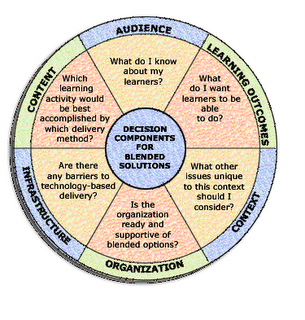By Sahar M. Talaat Abdel Bary
The key to blended learning is selecting the right combination of media that will drive the highest impact for the lowest possible cost (Bersin & Associates, 2003). Achieving these principles can be done through clarity on the performance objectives and so we need to perform a thorough instructional design analysis (Singh & Reed 2001 and Valiathan, 2002). The illustration below suggests a number of components to be considered during the process of instructional design (Douglis).
 This means that when we attempt to build an effective blended learning strategy, we will go through the following processes:
This means that when we attempt to build an effective blended learning strategy, we will go through the following processes:
* Completely integrated instructional design: Khan try to reframe these factors in an octagonal framework. The framework has eight dimensions: institutional, pedagogical, technological, interface design, evaluation, management, resource support, and ethical. Each dimension in the framework represents a category of issues that need to be addressed. These issues help organize thinking, and ensure that the resulting learning program creates a meaningful learning experience. 
* Institutional
The Institutional dimension addresses issues concerning organizational, administrative, academic affairs, and student services.
* Pedagogical
The Pedagogical dimension is concerned with the combination of content that has to be delivered (content analysis), the learner needs (audience analysis), and learning objectives (goal analysis). The pedagogical dimension also encompasses the design and strategy aspect of e-learning. This dimension addresses a scenario where all learning goals in a given program are listed and then the most appropriate delivery method is chosen.
* Technological
Once we have identified the delivery methods that are going to be a part of the blend, the Technology issues need to be addressed. Issues include creating a learning environment and the tools to deliver the learning program. This dimension addresses the need for the most suitable learning management system (LMS) that would manage multiple delivery types and a learning content management system (LCMS) that catalogs the actual content (online content modules) for the learning program. Technical requirements, such as the server that supports the learning program, access to the server, bandwidth and accessibility, security, and other hardware, software, and infrastructure issues are addressed.
* Interface Design:
The Interface Design dimension addresses factors related to the user interface of each element in the blended learning program. One needs to ensure that the user interface supports all the elements of the blend. & so the usability of the user interface will need to be analyzed. Issues like content structure, navigation, graphics, and help also can be addressed in this dimension.
* Evaluation:
The Evaluation dimension is concerned with the usability of a blended learning program. The program should have the capability to evaluate how effective a learning program has been as well as evaluating the performance of each learner.
* Management
The Management dimension deals with issues related to the management of a blended learning program, such as infrastructure and logistics to manage multiple delivery types. The management dimension also addresses issues like registration and notification, and scheduling of the different elements of the blend.
* Resource Support
The Resource Support dimension deals with making different types of resources (offline and online) available for learners as well as organizing them. Resource support could also be a counselor/tutor always available in person, via e-mail, or on a chat system.
* Ethical
The Ethical dimension identifies the ethical issues that need to be addressed when developing a blended learning program. Issues such as equal opportunity, cultural diversity, and nationality should be addressed ((Singh & Reed 2001 and Singh, 2003).
Steps for developing blended learning courses can be summarized in the following figure:

Selection of appropriate media is a very challenging and greatly increase the efficiency of blended learning courses. Many researches are concentrating on strengths and weaknesses of each media type, and from that researches “media selection guide” was produced.

References:
1. Bersin & Associates, 2003: Blended Learning: What Works?.
2. Douglis F, "Blended Learning: Choosing the Right Blend" in Encyclopedia of Educational learning
3. Rossett A., 2003: Strategies for Building Blended Learning: Allison, Felicia Douglis, and Rebecca V. Frazee, June 30.
4. Singh H, 2003: Building Effective Blended Learning Programs, Educational Technology, Volume 43, Number 6, Pages 51-54.
5. Singh H. & Reed C. 2001: Achieving Success with Blended Learning, Centra Software, 2001 ASTD State of the Industry Report, American Society for Training & Development.
6. Valiathan, P., 2002, "Blended Learning Models" Learning Circuits. www.learningcircuits.org/2002/aug2002/valiathan.html
0 Comments:
Post a Comment
<< Home